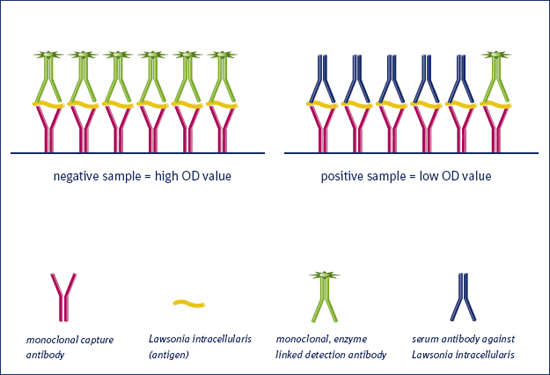5.1.4 Blocking ELISA (bELISA) for the detection of antibodies against Lawsonia intracellularis
A blocking ELISA is available that allows a semiquantitive monitoring of swine populations with a high throughput. The test can be automated using robot technology and the results evaluated on an objective basis, which improves repeatability and comparative analyses.
Principle of the test:
Lawsonia intracellularis antigen is bound to the ELISA plate by a specific monoclonal antibody (capture antibody). Serum samples diluted according to the test protocol (1:10) are incubated with the antigen template. Serum antibodies against Lawsonia intracellularis bind to the antigen. After removal of the serum, a secondary peroxidase labelled monoclonal antibody, which binds to an epitope of Lawsonia intracellularis, which differs from that of the capture antibody is added to the well. In the presence of swine antibodies that previously bound to the antigen template, no or fewer binding sites are available for the secondary monoclonal antibody, which results in less binding compared to that observed with the a negative control serum (inhibition). After incubation with a substrate is stopped, the binding of the conjugated monoclonal antibody gives a yellow colour, which can be measured using a photometer. Wells, incubated with the negative control serum serve as 100% reference. A positive swine serum serves as additional in-test control.
Note: Wells incubated without the addition of any serum will not give valid results.
Special equipment:
A photometer with 450 nm filters is needed to measure the optical density per well. An automated ELISA plate washer is recommended.
Result format:
Test results are calculated with the 100% reference value (negative control serum) according to the formula 100 – (OD test serum/OD 100% reference) x 100 as percent inhibition (PI). PI values are interpreted as positive, inconclusive or negative:

With some negative serum samples the binding of the monoclonal detection antibody is higher than that with the negative control serum. This will result in “negative PI values”. Nevertheless negative PI values are also scored negative.
For more detailed information, PI values of the individual sera can be charted and evaluated using statistical methods for process control or continuous process improvement.
Serologic assays have the advantage of being relatively cheap and easy to perform with good specificity. They have the disadvantage of only indicating that a positive pig has had a prior exposure to the disease agent (Lawsonia intracellularis), not that it is necessarily acutely infected at this day of investigation.
Note: Vaccine derived antibodies cannot be differentiated from field challenge derived antibodies by the use of existing serological assays.
Additionally, vaccination may stimulate little or no detectable serum antibodies, while providing protective immunity.

picture 5.1.4 a
Principal of the Ileitis blocking ELISA.

Table 5.1.4 a
Advantages and disadvantages of serological tests for Lawsonia intracellularis.
© Boehringer Ingelheim Animal Health GmbH, 2006
All rights reserved. No part of this Technical Manual 3.0 may be reproduced or transmitted in any form or by any means, electronic or photocopy, without permission in writing from Boehringer Ingelheim Animal Health GmbH.






